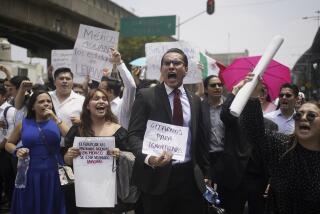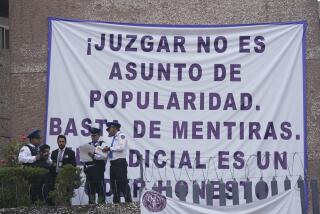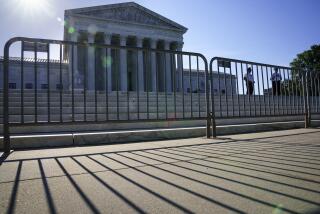Administration Calls for Wide Legal Reforms : Courts: Capping punitive damages, allowing judges to set penalties proposed. ‘Loser pays’ system also suggested.
- Share via
WASHINGTON — The Bush Administration called Tuesday for sweeping changes in the American legal system, including a plan to impose strict limits on punitive damages awarded in civil lawsuits and to transfer from juries to judges the power to set such penalties.
Among other major departures contained in a new Administration blueprint for reform are plans to restrict dramatically the testimony of “expert” witnesses and to introduce in certain cases a “loser pays” system of settling court costs.
The package also proposes splitting the U.S. 9th Circuit Court of Appeals, headquartered in San Francisco, whose jurisdiction extends from Montana to Guam, into smaller circuits in an effort to reduce the potential for “inconsistent decisions” by an unwieldy number of judges.
The proposals were described by Vice President Dan Quayle as a vital step in a bid to overhaul a costly, cumbersome civil justice system that he warned has become a “competitive disadvantage” for the United States.
But even advocates of legal reform described some features of the plan as unexpectedly extreme. And its central features won a chilly reception from consumer rights organizations and members of the American Bar Assn., to whom Quayle unveiled the plan in Atlanta.
In outlining more than a dozen major recommendations for reform put forth by the President’s Council on Competitiveness, Quayle suggested bluntly that the problems facing U.S. businessmen are compounded by a system tangled by too many lawyers and too many lawsuits.
“Does America really need 70% of the world’s lawyers?” Quayle asked members of the bar association. “Is it healthy for our economy to have 18 million new lawsuits coursing through the system annually?”
But ABA President John J. Curtin Jr. took immediate affront in a response that won cheers from association members and set the stage for what is certain to be a prolonged debate about the Administration proposals.
“You should reconsider the basic assumption that the lawyers of America are the reason why America is not competing more effectively in the world,” Curtin said in a sharp rebuttal that followed Quayle’s address.
“Drastically reducing the lawyers in America’s courtrooms will not make America more competitive in the marketplace,” Curtin said. If they are gone, he added, “who will protect the poor, the injured, the victims of negligence, the victims of racial discrimination and . . . violence?”
Quayle, who had stood beside Curtin while he delivered his criticism, immediately returned to the microphone.
“Nobody is talking about eliminating lawyers,” he said. “Nobody is talking about not allowing individuals to have their day in court. So let’s not be extreme. Let’s focus on the very fundamental problem and that is we should challenge the status quo. I am convinced we can have a better legal system in America if we sit down and work together.”
The Administration proposal is being advanced at a time of increasing concern about the amount of punitive damages--often totaling many millions of dollars--that may be assessed by juries against companies and individuals found liable in civil suits.
The extent to which those awards actually have increased in frequency and size remains a matter of dispute. At the same time, many consumer rights advocates contend that the threat of virtually unlimited punitive damages serves as an important deterrent to corporate misconduct.
But widespread disenchantment with cases in which punitive damages clearly have been excessive has made the subject a potent political issue. By putting his personal stamp on the Administration proposals, the vice president appears to be offering an early rehearsal for an important domestic theme.
Most of the proposals outlined Tuesday by Quayle and contained in the Administration’s new “Agenda for Civil Justice in America” would require the approval of states, Congress or federal judicial bodies before they would take effect.
But Quayle indicated that President Bush will soon sign an executive order that, in a sign of the Administration’s commitment to the proposals, would make federal government lawyers subject to some of the new restrictions. These would include the barriers against expert witnesses and a provision limiting the extent of “discovery” requests, which can cause simple lawsuits to assume the dimensions of massive paper mountains.
“This gives the government a kind of white hat,” one Administration official said, suggesting that the White House hopes to overcome resistance within the legal community to its plan by first demonstrating that “we can live” with the restrictions.
If adopted, the cap on punitive damages and other proposals described by Quayle as indications of the Administration’s willingness to “challenge the status quo” would indeed alter the civil justice system in significant and visible ways.
In most states, juries that find an individual liable in a civil lawsuit may now impose punitive damages in unlimited amounts over and above any “compensatory” award meant to reimburse victims for an actual injury.
But in what Quayle called an effort to “reduce the randomness of the system,” the Administration proposal would permit only judges to set penalties and would limit punitive awards to an amount no greater than the actual harm done.
Martin Connor, who as head of the American Tort Reform Assn. has been a chief advocate of efforts to limit punitive damages, said he welcomed the general outlines of the Administration proposal.
But, in a theme echoed by other legal reformers, he characterized as overly restrictive the low ceiling on punitive damages proposed by the Administration and described the proposal to shift responsibility from jury to judge as representing an extreme end of the spectrum.
An American University expert on tort law who opposes restrictions on punitive damages was more blunt in his criticism. “It has this horrific, elitist aroma,” academic dean Andrew F. Popper said of the effort to deprive juries of their award-granting powers.
Among the other Administration proposals, the plan to limit the testimony in federal court of expert witnesses to those whose opinions are based on established theory would mark the first such significant restriction in a system that now offers considerable latitude to those who claim expertise.
The approach would require the losing party in a civil case to pay the court and legal fees of the victor, a rule that critics believe could serve as a barrier to poor Americans who are considering legal action but cannot afford to pay the other side’s costs should they lose.
The Administration’s experimental proposal, however, would impose the “loser pays” rule only in those federal cases in which parties also had the option of pursuing the matter under more orthodox rules in state court.
The proposal to divide the 9th Circuit Court of Appeals into an unspecified number of smaller circuits was advanced in an effort “to avoid the potential for inconsistent decisions within the same judicial circuit,” according to the Administration proposal.
The document notes that an appeals court’s ability to issue clear legal guidance within its jurisdiction is diminished as the number of judges increases. It calls for congressional approval of legislation to split the 9th Circuit panel, which currently has 28 judges.
More to Read
Get the L.A. Times Politics newsletter
Deeply reported insights into legislation, politics and policy from Sacramento, Washington and beyond. In your inbox twice per week.
You may occasionally receive promotional content from the Los Angeles Times.










